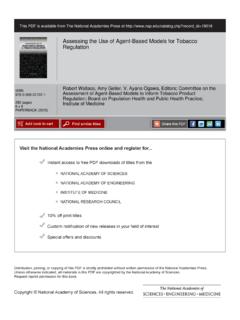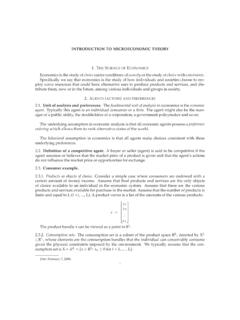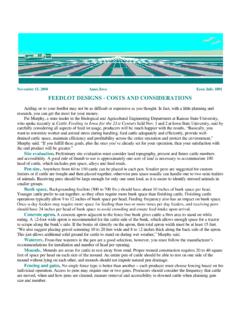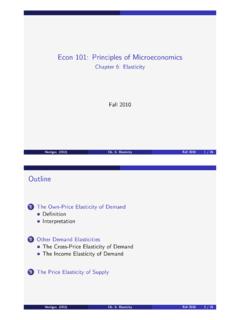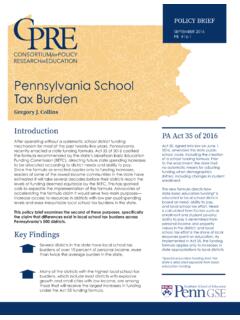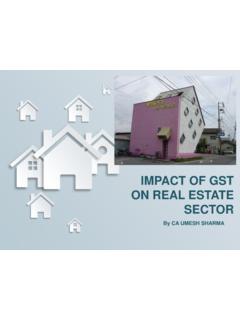Transcription of Econ 101: Principles of Microeconomics
1 econ 101 : Principles of MicroeconomicsChapter 7: TaxesFall 2010 Herriges (ISU)Ch. 7: TaxesFall 20101 / 25 Outline1 The Excise Tax2 The Benefits and Costs of Taxation3 Tax Fairness versus Tax Efficiency4 the tax SystemHerriges (ISU)Ch. 7: TaxesFall 20102 / 25 TaxesIn chapter 5, we looked at ways that the government intervenes in themarketplace using- Price ceilings- Price floors and/or price supports- QuotasHowever, we are used to a much more frequent form of governmentintervention:Taxes .. in this world nothing can be said to be certain, except death andtaxes. Benjamin Franklin (13 November 1789)Taxes are essential for government to , as we shall see, taxes also distort the incentives of themarketplace, creating losses in must trade-off the gains from government programsagainst the inefficiencies created in the process of raising the fundsnecessary for its we will look at a variety of tax forms, we will start with one ofthe simplest: the excise (ISU)Ch.
2 7: TaxesFall 20103 / 25 The Excise TaxThe Excise TaxAn excise tax is a tax charged on each unit of a good or service thatis not the same as a sales tax in that it is levied per unit of thegood, rather than as a percentage of the of excise taxes include taxes on- gasoline- cigarette- alcohol- hotel roomsAs these examples suggest, one of the typical reasons for excise taxesis to discourage consumption of the good ( , so-called sin taxes. )However, excise taxes are also levied as a source of (ISU)Ch. 7: TaxesFall 20104 / 25 The Excise TaxThe Impact of Excise Tax Levied on BuyersThe excise tax can be levied on either the buyer or the seller of we impose a $1/pack cigarette tax on buyersHerriges (ISU)Ch.
3 7: TaxesFall 20105 / 25 The Excise TaxThe Impact of Excise Taxes Levied on Buyers (cont d)The impact of the excise tax is to shift the demand curve faced byproducersdownby the amount of the creates a surplus of the (ISU)Ch. 7: TaxesFall 20106 / 25 The Excise TaxThe Impact of Excise Taxes Levied on Buyers (cont d)There are three consequences of the excise tax:1 The overall quantity sold is price paid by consumers for the product hasincreasedfromP ($3in our example) toP D($ in our example)3 The price received by producers for the product hasdecreasedfromP ($3 in our example) toP S($ in our example)Notice that the tax burden is not born solely by the consumer, eventhough the tax is levied on the bears the burden of the tax is referred to as the tax our example, the tax incidence is evenly split between the buyerand the isnottypically the case, but depends on the elasticities of supplyand (ISU)Ch.
4 7: TaxesFall 20107 / 25 The Excise TaxThe Impact of Excise Tax Levied on SellersSuppose, instead, that we impose the $1/pack cigarette tax on sellersThe effect of this tax is to shift the supply curve up by the amount ofthe (ISU)Ch. 7: TaxesFall 20108 / 25 The Excise TaxTax IncidenceIf you look at the outcome here, the result isidenticalto whathappened when the tax was levied on the buyer is an important lesson: Who actually pays the tax ( , the taxincidence) does not depend on who the tax is levied When the tax is levied on consumers, they reduce their WTP Producers have to reduce the price they charge consumers to get themto buy their productgiventhe new Conversely, when the tax is levied on producers, they pass a portion ofthis additional cost onto consumers in the form of higher tax incidence will depend on the price elasticities of supply the price elasticity of demand is higher than the price elasticityof supply.
5 An excise tax falls mainly on the price elasticity of supply is higher than the price elasticity ofdemand, an excise tax falls mainly on (ISU)Ch. 7: TaxesFall 20109 / 25 The Excise TaxTax Incidence: Demand More Elastic than SupplyHerriges (ISU)Ch. 7: TaxesFall 201010 / 25 The Excise TaxTax Incidence: Supply More Elastic than DemandHerriges (ISU)Ch. 7: TaxesFall 201011 / 25 The Benefits and Costs of TaxationThe Benefits and Costs of TaxationTracing out the benefits and costs of taxation requires understanding1what revenues are collected as result of the specific tax being used;2the benefits from the programs that the government undertakes; and3any inefficiencies created in the process of collecting the taxes and inspending the revenues , we will used an excise tax to illustrate the (ISU)Ch.
6 7: TaxesFall 201012 / 25 The Benefits and Costs of TaxationRevenuesThe amount of revenues collected by an excise tax depends upon:1 the tax rate: The amount of tax per unit of whatever is being tax base: The quantity of the good being the tax rate can either increase or decrease the total taxrevenue, depending upon1 The elasticity of demand;2 The elasticity of supply; and3 The size of the tax is because increasing the tax rate has two effects:1It increases the tax revenue per unit of the good taxed2It reduces the tax base by discouraging consumptionsHerriges (ISU)Ch. 7: TaxesFall 201013 / 25 The Benefits and Costs of TaxationChanging Revenues from a Tax IncreaseConsider the impact of raising our cigarette tax from $1 to $ (ISU)Ch.
7 7: TaxesFall 201014 / 25 The Benefits and Costs of TaxationCigarette Tax Increases in PracticeCigarette demand is inelastic (as is the case for most addictive substances.)StateYearTax IncreaseChange in Tax RevenueUtah1997$ + $ + $ + $ + York2000$ + increases in revenue aredespitelikely sales losses to neighboringstates and illegal (ISU)Ch. 7: TaxesFall 201015 / 25 The Benefits and Costs of TaxationThe Cost of TaxationThe cost of taxation isnotthe amount of money paid by the the tax revenue collected by the government is presumably spentproviding services desired by society as a.
8 Though there are costs here if the government provides those , even if the government uses taxes by providing socially desirablegoods and services there is a cost to taxation- This is because the tax distorts the market price, driving a wedgebetween consumer s MWTP and producer s This results in a deadweight lossThe deadweight loss will be larger- the more elastic supply is- the more elastic demand (ISU)Ch. 7: TaxesFall 201016 / 25 The Benefits and Costs of TaxationSurplus Loss with Excise TaxHerriges (ISU)Ch. 7: TaxesFall 201017 / 25 The Benefits and Costs of TaxationThe Deadweight LossThe deadweight loss is a real cost of the excise tax caused by thereduced consumption under the that were otherwise beneficial are lost because of the deadweight loss of a tax will be smaller if1 Demand is less elastic ( , the quantity demanded is not substantiallyaffected by the tax ).
9 2 Supply is less elastic ( , the quantity supplied is not substantiallyaffected by the tax )There can be additional losses due to the tax if the government isinefficient in providing its (ISU)Ch. 7: TaxesFall 201018 / 25 Tax Fairness versus Tax EfficiencyTwo Principles of Tax FairnessDifferent forms of taxes vary substantially in terms of who pays thetax, particularly if you take into account the actual incidence of thetax as opposed to who writes the check. There are two basic Principles that are used to justify the fairness of a tax:1 The benefits principle: Those who benefit from public spending shouldbear the burden of the tax that pays for that The federal gasoline tax is an example in that it is used for themaintenance and improvement of federal However, gasoline usage and highway usage are not perfectly The benefits principle is not frequently used as the justification ability-to-pay principle.
10 Those with a greater ability to pay a taxshould pay more This concept is typically extended to mean that, not only should thewealthier pay more absolutely, but that they should pay a higherpercentage of their (ISU)Ch. 7: TaxesFall 201019 / 25 the tax SystemThe US Tax SystemThe US tax system is made up a variety of programs, including1 Income tax: a tax that depends on the income of the individual orfamily from wages and tax: a tax that depends on the earnings an employer pays to tax: a tax that depends on the value of goods tax: a tax that depends on the firm s tax a tax that depends on the value of property ( , one shome)6 Wealth tax a tax that depends on an individual s taxes differ in terms of the- the tax base.


